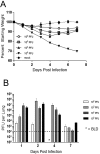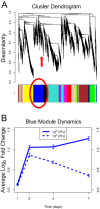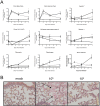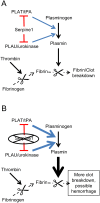Mechanisms of severe acute respiratory syndrome coronavirus-induced acute lung injury
- PMID: 23919993
- PMCID: PMC3747576
- DOI: 10.1128/mBio.00271-13
Mechanisms of severe acute respiratory syndrome coronavirus-induced acute lung injury
Abstract
Systems biology offers considerable promise in uncovering novel pathways by which viruses and other microbial pathogens interact with host signaling and expression networks to mediate disease severity. In this study, we have developed an unbiased modeling approach to identify new pathways and network connections mediating acute lung injury, using severe acute respiratory syndrome coronavirus (SARS-CoV) as a model pathogen. We utilized a time course of matched virologic, pathological, and transcriptomic data within a novel methodological framework that can detect pathway enrichment among key highly connected network genes. This unbiased approach produced a high-priority list of 4 genes in one pathway out of over 3,500 genes that were differentially expressed following SARS-CoV infection. With these data, we predicted that the urokinase and other wound repair pathways would regulate lethal versus sublethal disease following SARS-CoV infection in mice. We validated the importance of the urokinase pathway for SARS-CoV disease severity using genetically defined knockout mice, proteomic correlates of pathway activation, and pathological disease severity. The results of these studies demonstrate that a fine balance exists between host coagulation and fibrinolysin pathways regulating pathological disease outcomes, including diffuse alveolar damage and acute lung injury, following infection with highly pathogenic respiratory viruses, such as SARS-CoV.
Importance: Severe acute respiratory syndrome coronavirus (SARS-CoV) emerged in 2002 and 2003, and infected patients developed an atypical pneumonia, acute lung injury (ALI), and acute respiratory distress syndrome (ARDS) leading to pulmonary fibrosis and death. We identified sets of differentially expressed genes that contribute to ALI and ARDS using lethal and sublethal SARS-CoV infection models. Mathematical prioritization of our gene sets identified the urokinase and extracellular matrix remodeling pathways as the most enriched pathways. By infecting Serpine1-knockout mice, we showed that the urokinase pathway had a significant effect on both lung pathology and overall SARS-CoV pathogenesis. These results demonstrate the effective use of unbiased modeling techniques for identification of high-priority host targets that regulate disease outcomes. Similar transcriptional signatures were noted in 1918 and 2009 H1N1 influenza virus-infected mice, suggesting a common, potentially treatable mechanism in development of virus-induced ALI.
Figures






Similar articles
-
Complement Activation Contributes to Severe Acute Respiratory Syndrome Coronavirus Pathogenesis.mBio. 2018 Oct 9;9(5):e01753-18. doi: 10.1128/mBio.01753-18. mBio. 2018. PMID: 30301856 Free PMC article.
-
Overactive Epidermal Growth Factor Receptor Signaling Leads to Increased Fibrosis after Severe Acute Respiratory Syndrome Coronavirus Infection.J Virol. 2017 May 26;91(12):e00182-17. doi: 10.1128/JVI.00182-17. Print 2017 Jun 15. J Virol. 2017. PMID: 28404843 Free PMC article.
-
Distinct severe acute respiratory syndrome coronavirus-induced acute lung injury pathways in two different nonhuman primate species.J Virol. 2011 May;85(9):4234-45. doi: 10.1128/JVI.02395-10. Epub 2011 Feb 16. J Virol. 2011. PMID: 21325418 Free PMC article.
-
Inflammation, Thrombosis, and Destruction: The Three-Headed Cerberus of Trauma- and SARS-CoV-2-Induced ARDS.Front Immunol. 2020 Sep 25;11:584514. doi: 10.3389/fimmu.2020.584514. eCollection 2020. Front Immunol. 2020. PMID: 33101314 Free PMC article. Review.
-
Viral pathogens and acute lung injury: investigations inspired by the SARS epidemic and the 2009 H1N1 influenza pandemic.Semin Respir Crit Care Med. 2013 Aug;34(4):475-86. doi: 10.1055/s-0033-1351122. Epub 2013 Aug 11. Semin Respir Crit Care Med. 2013. PMID: 23934716 Free PMC article. Review.
Cited by
-
COVID-19-associated coagulopathy: An exploration of mechanisms.Vasc Med. 2020 Oct;25(5):471-478. doi: 10.1177/1358863X20932640. Epub 2020 Jun 19. Vasc Med. 2020. PMID: 32558620 Free PMC article. Review.
-
Possible Potential Effects of Honey and Its Main Components Against Covid-19 Infection.Dose Response. 2021 Mar 30;19(1):1559325820982423. doi: 10.1177/1559325820982423. eCollection 2021 Jan-Mar. Dose Response. 2021. PMID: 33867892 Free PMC article. Review.
-
ANDC: an early warning score to predict mortality risk for patients with Coronavirus Disease 2019.J Transl Med. 2020 Aug 31;18(1):328. doi: 10.1186/s12967-020-02505-7. J Transl Med. 2020. PMID: 32867787 Free PMC article.
-
Research and Management of Rare Diseases in the COVID-19 Pandemic Era: Challenges and Countermeasures.Front Public Health. 2021 Apr 15;9:640282. doi: 10.3389/fpubh.2021.640282. eCollection 2021. Front Public Health. 2021. PMID: 33937170 Free PMC article. Review.
-
Decoding the enigma of antiviral crisis: Does one target molecule regulate all?Cytokine. 2019 Mar;115:13-23. doi: 10.1016/j.cyto.2018.12.008. Epub 2019 Jan 4. Cytokine. 2019. PMID: 30616034 Free PMC article. Review.
References
-
- Ksiazek TG, Erdman D, Goldsmith CS, Zaki SR, Peret T, Emery S, Tong S, Urbani C, Comer JA, Lim W, Rollin PE, Dowell SF, Ling AE, Humphrey CD, Shieh WJ, Guarner J, Paddock CD, Rota P, Fields B, DeRisi J, Yang JY, Cox N, Hughes JM, LeDuc JW, Bellini WJ, Anderson LJ. 2003. A novel coronavirus associated with severe acute respiratory syndrome. N. Engl. J. Med. 348:1953–1966 - PubMed
-
- Zaki AM, van Boheemen S, Bestebroer TM, Osterhaus AD, Fouchier RA. 2012. Isolation of a novel coronavirus from a man with pneumonia in Saudi Arabia. N. Engl. J. Med. 367:1814–1820 - PubMed
Publication types
MeSH terms
Substances
Grants and funding
LinkOut - more resources
Full Text Sources
Other Literature Sources
Medical
Molecular Biology Databases
Miscellaneous

